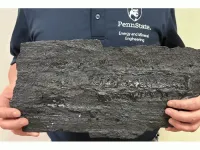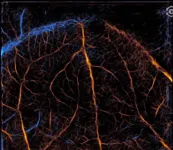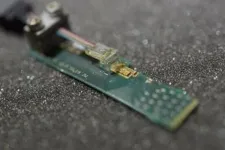(Press-News.org) UNIVERSITY PARK, Pa. — The quest to develop hydrogen as a clean energy source that could curb our dependence on fossil fuels may lead to an unexpected place — coal. A team of Penn State scientists found that coal may represent a potential way to store hydrogen gas, much like batteries store energy for future use, addressing a major hurdle in developing a clean energy supply chain.
“We found that coal can be this geological hydrogen battery,” said Shimin Liu, associate professor of energy and mineral engineering at Penn State. “You could inject and store the hydrogen energy and have it there when you need to use it.”
Hydrogen is a clean burning fuel and shows promise for use in the most energy intensive sectors of our economy — transportation, electricity generation and manufacturing. But much work remains to build a hydrogen infrastructure and make it an affordable and reliable energy source, the scientists said.
This includes developing a way to store hydrogen, which is currently expensive and inefficient. Geologic formations are an intriguing option, the scientists said, because they can store large amounts of hydrogen to meet the peaks and valleys as energy demand changes daily or seasonally.
“Coal is well-studied, and we have been commercially producing gas from coal for almost a half century,” Liu said. “We understand it. We have the infrastructure. I think coal would be the logical place to do geological hydrogen storage.”
To put this to the test, the scientists analyzed eight types of coals from coalfields across the United States to better understand their sorption and diffusion potential, or how much hydrogen they can hold.
All eight coals showed considerable sorption properties, with low-volatile bituminous coal from eastern Virgina and anthracite coal from eastern Pennsylvania performing the best in tests, the scientists reported in the journal Applied Energy.
“I think it’s highly possible that coal could be the very top selection for geological storage from a scientific perspective,” said Liu. “We find that coal outperforms other formations because it can hold more, it has existing infrastructure and is widely available across the country and near populated areas.”
Depleted coalbed methane reservoirs may be the best candidates. These seams contain unconventional natural gas like methane and have become an important source of fossil fuel energy over the last several decades. The methane sticks to the surface of the coal, in a process called adsorption.
Similarly, injecting hydrogen into coal would cause that gas to absorb or stick to the coal. These formations often have a layer of shale or mudstone on top that act as a seal keeping methane, or in this case hydrogen, sealed until it is needed and pumped back out, the scientists said.
“A lot of people define coal as a rock, but it’s really a polymer,” Liu said. “It has high carbon content with a lot of small pores that can store much more gas. So coal is like a sponge that can hold many more hydrogen molecules compared to other non-carbon materials.”
The scientists designed special equipment to conduct the experiments. Coal has a weaker affinity with hydrogen compared to other sorbing gases like methane and carbon dioxide, so traditional pressurized equipment for determining sorption would not have worked.
“We did a very novel and very challenging design,” Liu said. “It took years to figure out how to do this properly. We had to properly design an experiment system, trial and error based on our previous experience with coals and shales.”
Based on their results, the scientists determined anthracite and semi-anthracite coals are good candidates for hydrogen storage in depleted coal seams, and low-volatile bituminous coal are better candidates for gassy coal seams.
Developing hydrogen storage in coal mining communities could bring new economic opportunities to these regions while also helping create the nation’s hydrogen infrastructure.
“In the energy transition, it’s really coal communities that have been the most impacted economically,” Liu said. “This is certainly an opportunity to repurpose the coal region. They already have the expertise — the energy engineer and skills. If we can build an infrastructure and change their economic opportunities — I think that’s something we should consider.”
Future work will focus on the dynamic diffusivity and dynamic permeability of coal, features which determine how quickly hydrogen can be injected and pumped back out, the scientists said.
“I think Penn State is the right place to do all this research — we have the coal reserves, we have natural gas, we have both the engineering and economic expertise at the University,” Liu said. “This is the logical place to do this.”
Also contributing from Penn State was Ang Liu, instructor, John and Willie Leone Family Department of Energy and Mineral Engineering.
END
Hydrogen battery: Storing hydrogen in coal may help power clean energy economy
2023-05-25
ELSE PRESS RELEASES FROM THIS DATE:
Artificial muscle fibers could serve as cell scaffolds
2023-05-25
In two new studies, North Carolina State University researchers designed and tested a series of textile fibers that can change shape and generate force like a muscle. In the first study, the researchers focused on the materials’ influence on artificial muscles’ strength and contraction length. The findings could help researchers tailor the fibers for different applications.
In the second, proof-of-concept study, the researchers tested their fibers as scaffolds for live cells. Their findings suggest the fibers – known as “fiber robots” ...
Argonne hosts demo day for Lab-Embedded Entrepreneurship Program
2023-05-25
Twenty startups will present their technologies for a clean energy future at this year’s Lab-Embedded Entrepreneur Program (LEEP) Demo Day, June 7, in Chicago. LEEP connects entrepreneurs with resources and innovation ecosystems at U.S. Department of Energy (DOE) national labs.
In addition to demos from companies currently participating in LEEP, the event at the Sheraton Grand Chicago Riverwalk will also feature a panel discussion where program graduates share insights and advice about successful entrepreneurship. The technologies on display span renewable energy, materials for clean energy and water, batteries, ...
Helping virtual reality reflect social realities
2023-05-25
Research on virtual reality is expanding as the technology grows, but too much of that research is being conducted with participants who don’t reflect the general population.
The Virtual Experience Research Accelerator (VERA), a $5 million National Science Foundation-funded project, is creating a system to provide researchers with access to large, reliable, diverse groups of participants for an array of research projects on and using VR.
“A lot of research in this area suffers from using participant samples ...
New method tracking changes in blood vessels could advance brain disease detection
2023-05-25
PROVIDENCE, R.I. [Brown University] — While age-related brain disorders like Alzheimer’s disease often develop slowly across an individual’s lifetime, they usually aren’t detected until symptoms have already started. With that in mind, teams of biomedical researchers led by Brown University scientists have been exploring for years whether devastating neurodegenerative diseases could be caught decades earlier — perhaps through something as simple as a routine eye exam instead of a battery of diagnostic tests.
In a new study, one of the Brown-led ...
New framework for super-resolution ultrasound
2023-05-25
Researchers at the Beckman Institute for Advanced Science and Technology used deep learning to develop a new framework for super-resolution ultrasound.
Traditional super-resolution ultrasound techniques use microbubbles: tiny spheres of gas encased in a protein or lipid shell. Microbubbles are considered to be a contrast agent, which means they can be injected into a blood vessel to increase the clarity of an ultrasound image.
Conventional ultrasound has been commonplace for over 50 years. The development of super-resolution technology in the last decade has introduced new challenges. Super-resolution ultrasound provides a much clearer picture than the traditional method. ...
Simon Fraser University becomes global instructor training facility for Siemens mechatronic systems certification program
2023-05-25
Responding to a growing need for training in automation systems in Canada and globally, Siemens and Simon Fraser University (SFU) have announced that SFU is the first and only training facility for instructors delivering the globally recognized Level 3 Siemens Mechatronic Systems Certification program (SMSCP). Instructors, upon completion of the two-week long training will be qualified to deliver the Level 3 certification mechatronics training, vital for providing students with real-world technical skills, and helping prepare them to thrive in a high-tech world of work. Level 1 and Level 2 ...
Reconstructing brain connectivity using 3D images
2023-05-25
Dr. Shuiwang Ji, a professor in the Department of Computer Science and Engineering at Texas A&M University, is part of a collaborative research community that recently had its paper titled “BigNeuron: a resource to benchmark and predict performance of algorithms for automated tracing of neurons in light microscopy datasets” published in the April issue of the journal Nature Methods.
Initiated in 2015 and led by the Allen Institute for Brain Science, BigNeuron is an international initiative that brings together computer scientists and neuroscientists from a dozen institutions. ...
Words matter: How researchers can avoid stigmatizing language
2023-05-25
Word choice matters—a lot— when it comes to research. That’s the main takeaway from a new article co-authored by Edson College of Nursing and Health Innovation Assistant Professor Angel Algarin and published in Health Communication.
“Researchers in any field should be cognizant of the language they’re using to describe the people they study so they don’t inadvertently add to the use of stigmatizing language,” said Algarin.
For the article, Algarin and his co-authors performed a content ...
Chip-based QKD achieves higher transmission speeds
2023-05-25
WASHINGTON — Researchers have developed a quantum key distribution (QKD) system based on integrated photonics that can transmit secure keys at unprecedented speeds. The proof-of-principle experiments represent an important step toward real-world application of this highly secure communication method.
QKD is a well-established method of providing secret keys for secure communication between distant parties. By using the quantum properties of light to generate secure random keys for encrypting and ...
The brain’s protein-destruction machine learns new tricks at synapses, revealing a potential target for treating neurological disorders
2023-05-25
Darwin’s theory of evolution highlighted the importance of adaption and diversity in the natural world. Inside a biological cell, can proteins also perform new functions in new contexts? The answer seems to be yes for the brain’s primary protein-degradation machine, especially when it is placed at synapses, revealing a hitherto unknown mechanism that allows synapses to change in response to different circumstances.
The role of the regulatory (19S) proteasome particle has always been exclusively linked to its functioning in the proteasome complex, where it collaborates with the catalytic (20S) particle to recognize ...





